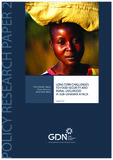| dc.description.abstract | Although there have been numerous concerted e orts aimed at halting the deterioration of the global food
security situation, available evidence indicates only a modest level of success especially in Sub-Sahara Africa
(SSA). The region harbors about 180 million of food insecure people and had in the past experienced an
increase in the number of the undernourished by 24 million people between 2003 and 2009. In addition, child
malnutrition is projected to continue worsening well beyond 2030 and energy intake and other dietary needs
in SSA have been characterized either by stagnation or decline compared to the upward global trend between
mid 1960 and the late 1990s. This paper aims at informing agricultural policy dialogue by examining the long
term challenges to food security and rural livelihood in SSA. Through a critical review of a wide range of literature,
the paper provides a synthesis of the nature and pattern of food security challenges, their likely impacts
and the opportunities for mitigating the challenges in the region. The economies of many countries in SSA
depend heavily on agriculture with the sector playing signi cant roles in national poverty reduction and food
security strategies. Up until early 2000, the sector generally went through policy and budgetary neglect that
led to growth stagnation but there is guarded optimism now: agricultural GDP in SSA as a whole grew by more
than 3.5 percent in 2008, surpassing the population growth rate, and grain production growth rates have been
kept above 3.0 percent. But, despite the positive trends, SSA agriculture remains uncompetitive in the global
market and the region as a whole is increasingly becoming a net food importer of major food grains thus
increasing its vulnerability to food price volatility in the global markets. Furthermore, SSA still faces challenges
in translating agricultural growth (as well as improved political democracy and international goodwill) into
real gains in food security and nutritional status of the majority of its people. The region is yet to deal comprehensively
with a number of problems: agriculture’s low absorptive capacity partly due to weak institutional
capacity; low per capita incomes that restrict e ective demand; lack of social equity in resource ownership;
diseases such as malaria and HIV/AIDS; persistent insecurity hot spots; and, high level corruption. These problems
are likely to be compounded in future by climate change impacts in the face of numerous pockets of
highly vulnerable communities, especially those living in arid and semi-arid zones; lack of resources needed
for climate change adaptation; rising rural populations combined with high incidence of poverty and rising
dependency ratios; scarcity of arable land (a consequence of both rising populations and degradation); and,
urban youth unemployment. The paper o ers strategies not just for managing the future challenges to food
security in SSA but also recommends ways of taking advantage of the opportunities that are likely to emerge,
for example, from rising urban populations and per capita incomes, increased food supply responsiveness by
smallholder farmers and agro-processors, international cooperation and support, and increased investment
in ows due to deepening of south-south cooperation. | en |

